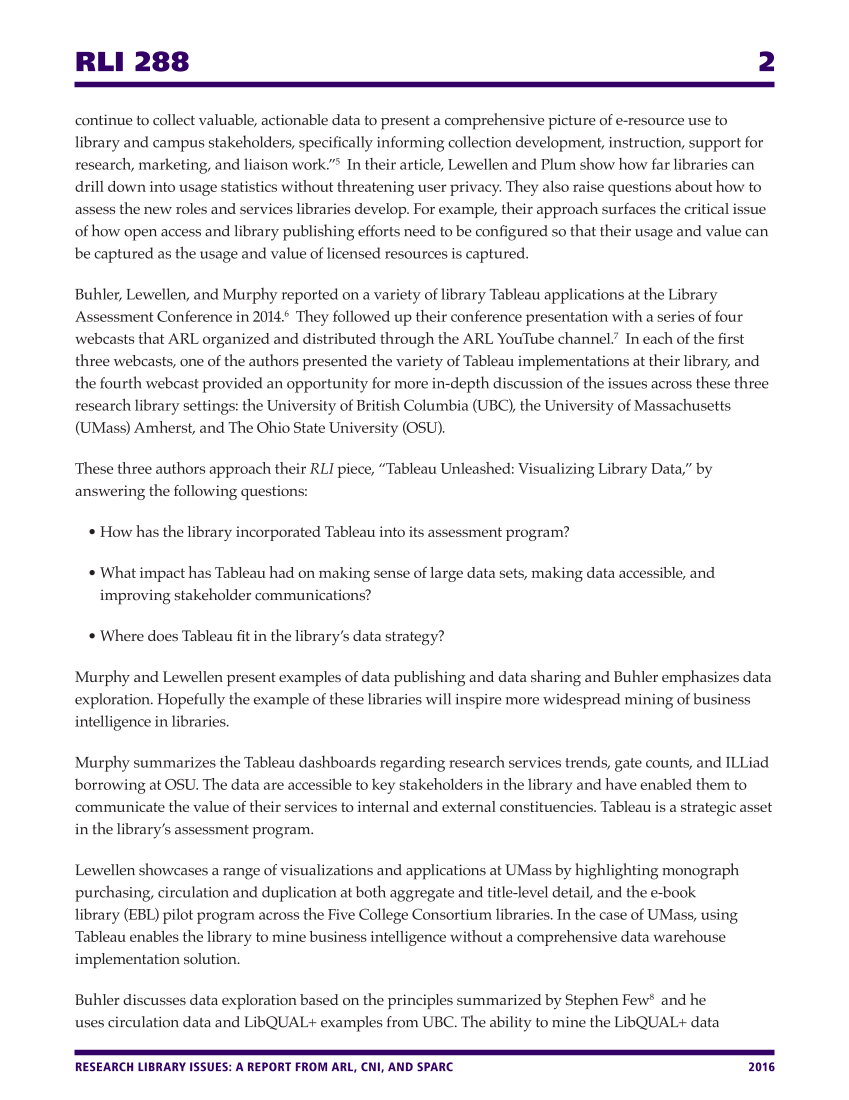RLI 288 2 RESEARCH LIBRARY ISSUES: A REPORT FROM ARL, CNI, AND SPARC 2016 continue to collect valuable, actionable data to present a comprehensive picture of e-resource use to library and campus stakeholders, specifically informing collection development, instruction, support for research, marketing, and liaison work.”5 In their article, Lewellen and Plum show how far libraries can drill down into usage statistics without threatening user privacy. They also raise questions about how to assess the new roles and services libraries develop. For example, their approach surfaces the critical issue of how open access and library publishing efforts need to be configured so that their usage and value can be captured as the usage and value of licensed resources is captured. Buhler, Lewellen, and Murphy reported on a variety of library Tableau applications at the Library Assessment Conference in 2014.6 They followed up their conference presentation with a series of four webcasts that ARL organized and distributed through the ARL YouTube channel.7 In each of the first three webcasts, one of the authors presented the variety of Tableau implementations at their library, and the fourth webcast provided an opportunity for more in-depth discussion of the issues across these three research library settings: the University of British Columbia (UBC), the University of Massachusetts (UMass) Amherst, and The Ohio State University (OSU). These three authors approach their RLI piece, “Tableau Unleashed: Visualizing Library Data,” by answering the following questions: • How has the library incorporated Tableau into its assessment program? • What impact has Tableau had on making sense of large data sets, making data accessible, and improving stakeholder communications? • Where does Tableau fit in the library’s data strategy? Murphy and Lewellen present examples of data publishing and data sharing and Buhler emphasizes data exploration. Hopefully the example of these libraries will inspire more widespread mining of business intelligence in libraries. Murphy summarizes the Tableau dashboards regarding research services trends, gate counts, and ILLiad borrowing at OSU. The data are accessible to key stakeholders in the library and have enabled them to communicate the value of their services to internal and external constituencies. Tableau is a strategic asset in the library’s assessment program. Lewellen showcases a range of visualizations and applications at UMass by highlighting monograph purchasing, circulation and duplication at both aggregate and title-level detail, and the e-book library (EBL) pilot program across the Five College Consortium libraries. In the case of UMass, using Tableau enables the library to mine business intelligence without a comprehensive data warehouse implementation solution. Buhler discusses data exploration based on the principles summarized by Stephen Few8 and he uses circulation data and LibQUAL+ examples from UBC. The ability to mine the LibQUAL+ data





































